Environmental Stewards
We foster an academic community where students, staff, and parents are compassionate, caring, and health-conscious individuals. Beginning in Kindergarten and continuing through 8th grade, students are taught and encouraged to articulate their needs and self-advocate. Service learning projects are a core component of the school curriculum, shaping students to become global citizens.
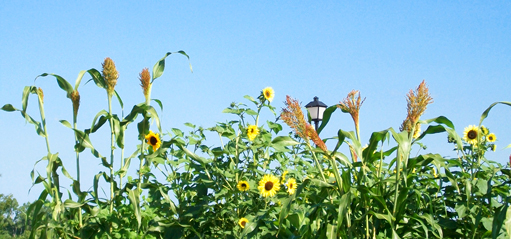
Our students learn to work within a broad community of learners, including those of different ages, community groups, and schools. Within the PCCS community, students practice the art of learning and discover how it leads to high achievement. They come to understand that natural and human communities are one and that environmental stewardship and civic responsibility go hand in hand. PCCS’s students gain a love for learning and a care for the earth and its citizens that will continue to develop after they have graduated.
Whether it be our buildings and grounds,our integrated environmental curricula or the best practices that are embedded in our programs. PCCS keeps the environment at the center of everything we do.
The Green Team
More to Come Soon!
Sustainable Buildings
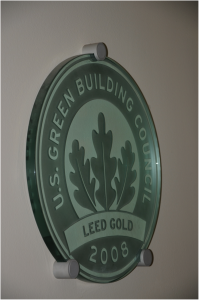
Some of the unique features of the PCCS building design are as follows:
Architecture
The classroom buildings were designed with an east-west orientation and with large overhangs to minimize direct thermal grain sunlight. “Study nooks” adjacent to each classroom provide flexible space that can be used differently from classroom-to-classroom and even day-to-day. The exterior skin of the building is designed as a rainscreen – air flow is allowed behind the wetting surface of the building’s skin to allow it to properly dry thus increasing its life and performance.
Mechanical Systems
A geothermal system provides heating and cooling for the buildings. For heating, the choice of a radiant floor system not only delivers heat low where it is most needed by students, it also cleans the air naturally as the hot air rises and is exhausted high. For natural ventilation, operable exterior windows allow natural breezes to filter through the classrooms, passing air through operable, clerestory windows to the corridor and out of the building through motor operated windows at the peak of the corridor ceiling.
Lighting
Daylight is extensive throughout the buildings. In the classrooms, almost continuous clerestory windows are supplemented with view glass. Natural light is abundant in interior spaces through high, north facing roof monitors. Finally, nearly all of the lights are fluorescent, maximizing efficacy and bulb life.
Water Usage
Inside, dual flush toilets and censored faucets not only minimize water usage, but make students aware of their consumption. Outside, rain water cisterns collect water that falls on portions of the roof and stores it for site irrigation. Also, rain dispersal eave treatments are used in lieu of gutters which allow the surrounding native landscape to absorb the rainwater naturally.
Materials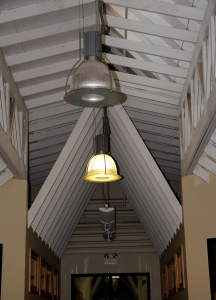
Fundamentally, the buildings were planned to minimize material use. This included programming to “right size” the building which lead to the following choices:
The concrete floor was stained rather than adding another layer of material like wood floors or carpet.
- Corridor roof trusses were left exposed and metal straps replaced an entire layer of plywood.
- Where finished appropriate for a classroom were required, naturally renewable cork and bamboo were chosen.
- Very basic building components like recycled content drywall, ceiling tile and porcelain tile were specified to take advantage of resources that have already been processed.
PCCS was awarded a Gold Rating by The Leadership in Energy and Environmental Design (LEED) Green Building Rating System for the School’s construction and is the first LEED-rated School in Illinois. LEED is affiliated with the U.S. Green Building Council (USGBC), and its rating system is the nationally accepted benchmark for the design, construction, and operation of high-performance green buildings. Ratings are based upon six criteria: sustainable sites, water efficiency, energy and atmosphere, materials and resources, indoor environmental quality, and innovation and design process. Awards ranging from Certification to Platinum are given based on achievement of LEED’s criteria.
Documents and Articles Featuring Prairie Crossing Charter School’s environmentally responsible campus:
Sustainable Culture
Interpretive Signage 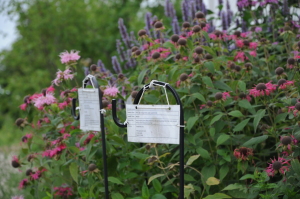
In order to share the uniqueness of our learning style and promote environmental awareness and best practices to all visitors to our campus, we have incorporated interpretive signage to inform people about both the sustainable elements of the campus. Permanent signage highlights some of the campus’ green features such as stormwater management, alternate forms of energy and reusable materials. In addition, our campus highlights seasonal student-generated phenology signs that highlight the natural occurrences they observe on campus.
Trash Free 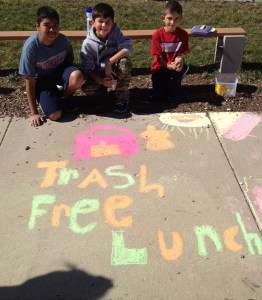
Prairie Crossing Charter School encourages each student to bring a trash free lunch and snack to school. Trash-free lunches is green environmentally and economically. There are many helpful tips and strategies for packing a trash-free lunch. Many excellent products are available both at stores and online. While PCCS does not promote or endorse any specific products, Waste Free Lunches offer suggestions and ideas for products and strategies that will help families pack trash-free lunches.
Let’s GO (Go Outside)
Our students experience the outdoors nearly everyday. Unless the weather poses a threat to safety, our students venture beyond the classroom walls to continue their learning. Across all disciplines PCCS utilizes its campus and sustainable surroundings to enhance experiential learning. From Solo Spots and Book Buddies to entire classrooms and group projects our teachers and students engage the outdoors in their lessons and learning. On average students in all grade levels spend 4 times the amount of time outside compared to our neighboring schools. The results consistently ranks PCCS as a top performing school in the State.
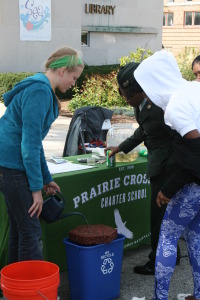 Community Service
Community Service
Through the course of becoming Natural Leaders, our students work with our neighboring communities to help spread the importance of environmental awareness. Whether it be at national conferences, state led initiatives or to local community events, PCCS students are ambassadors of environmental education and represent their school as voices of the next generation of leaders.
Sustainable Surroundings
Prairie Crossing Community
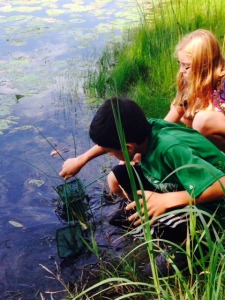
We are fortunate to be located in the Prairie Crossing Community, a critically-acclaimed Conservation Community that was designed to combine responsible development, the preservation of open land and easy commuting by rail. It is now considered a national example of how to design our communities to support a better way of life. Ten important principles established by the community’s founders have guided Prairie Crossing since its inception. Together, these Guiding Principles provide the framework for a way of life that respects the environment and enables residents to experience a strong connection between community and the land. It supports our mission and uniqueness of our charter and is available, literally out our back doors.
Prairies, Woodlands,Wetlands and a Lake
Immediately adjacent of our school boundaries and our own Campus is more than 165 acres of restored prairies, 20 acres of restored wetlands, and 16 acres of historic hedgerows, all contributing to the restoration of the native ecology of the region. Our neighbor to the west is Lake Aldo Leopold, named for the famed Wisconsin conservationist and writer. It is a 22-acre detention that handles all of the stormwater in the area while staying clean enough for swimming and recreation. The water quality is so high that the Illinois Department of Natural Resources uses Lake Aldo Leopold as a site for stocking endangered native minnows and other fish that are critical to a healthy biodiversity.
Liberty Prairie Reserve
Within a 5 minute walk to the east of the Comstock Building, puts our students at the entrance of the 5000+ acre Liberty Prairie Reserve. The Reserve is an ongoing story of how people and institutions can work together to preserve precious open space for people and wildlife. Here you will find tallgrass prairie, wetlands, oak savannas, rolling farm fields, and forests all within a short distance of residential communities. It is a place of beauty and a place where people are striving to live with nature. The Liberty Prairie Reserve is listed as one of America’s “Last Chance Landscapes” by Scenic America. The Reserve is a great place to explore with 14 miles of trails for walking, biking and providing the opportunity to experience learning through the environment and connecting to nature.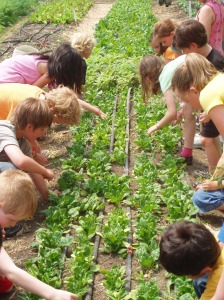
Prairie Crossing Farm.
Less than a 10 minute walk to the west of the Carson Building, our students enter a 100-acre working organic farm. In partnership with the The Liberty Prairie Foundation , which owns the farm and operates a variety of on-site programs including a Farm Business Development Center and other educational programs, our students learn the value of healthy land equals healthy people. The Prairie Crossing Farm provides a demonstration of successful local food businesses and our local food systems work in action, which influence our own Sustainable School Yard initiatives and support our Farm to Table program.